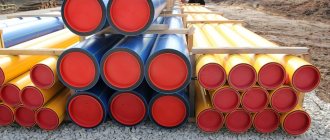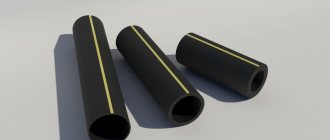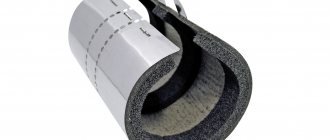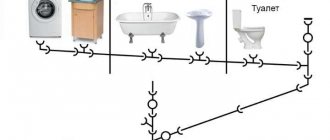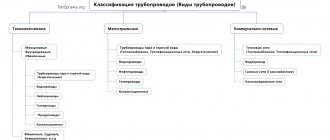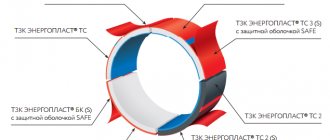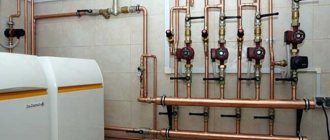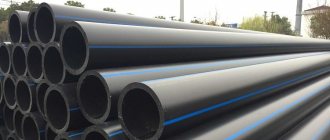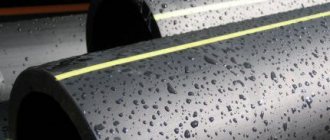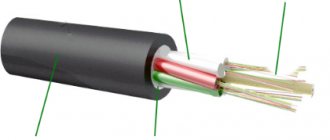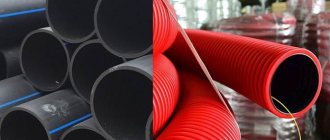Previously, when installing industrial and household communications, pipes made of cast iron, steel, and copper were used. With the advent of polymers that are not inferior to metal products in strength, wear resistance and inertness to chemicals, pipe material began to be produced from polypropylene, polyethylene, polyvinyl chloride, polybutylene, etc.
Polyethylene pipes for gas pipelines have proven themselves to be practical, flexible, lightweight, making transportation and installation much easier. If you decide to gasify a private house, then it would be a good idea to learn in more detail about the technical characteristics, conditions and methods of installing polyethylene pipes.
HDPE pipes for gas pipelines
Low-density polyethylene is used not only for the manufacture of gas pipeline elements. It is also used for the installation of other communications - water supply, sewerage, protective technical pipelines. Types of pipes differ in composition, characteristics, and markings.
Let us dwell on products for gas transportation, the production of which is subject to the requirements of GOST R 50838-2009 (outdated edition - GOST R 50838-95).
Types and sizes
Polymer pressure pipes for gas can consist only of polyethylene or are reinforced with additional layers.
Thus, there are three types:
- polyethylene, including those marked with yellow stripes;
- polyethylene with co-extrusion layers located inside or outside;
- polyethylene with a thermoplastic protective shell, which must be removed before installation.
All types of pipe material are designed for transporting various gases that comply with GOST 5542 standards and are used as raw materials or fuel for industrial and domestic needs. Restrictions for the use of pipelines are accepted: max. pressure – 1.2 MPa, max. work. temperature -/+40°С.
Pipes are sold in packages of various types: products with a diameter of 200 mm and above - only in straight sections, thinner ones - in coils or coils
Industrial products are supplied in sections of 5-24 m, multiples of 0.25 m, but more often than average length, convenient for transportation by special equipment - for example, 13 m. Winding a thin pipe in a coil requires different lengths, but more often you can find coils of 200, 500, 700 m. It is possible to produce products of other lengths, but only by agreement with customers.
Depending on the thickness of the walls and slave. pipe pressures are divided into two types:
- PE-80 . Wall thickness – 2-3 mm, working. pressure – 3-6 MPa; suitable for gas and water pipelines;
- PE-100 . Wall thickness – 3.5 mm, working. pressure – 8-12 MPa; This is an improved version of PE 80, characterized by heat resistance and increased density.
PE (options - PE, PE) in the name is polyethylene, the numbers 80 and 100 are grades of polyethylene.
From the point of view of economic feasibility, the PE 100 grade is used when installing a high-pressure gas pipeline or in special cases - for example, for the reconstruction of an old worn-out main line or the construction of experimental branches with a pressure of 0.6 MPa and above.
Technical characteristics and markings
Factory-manufactured polyethylene pipes are subject to the requirements listed in GOST R 50838-2009. These include recommendations for appearance and technical properties.
Externally, the pipes must have a smooth surface, without bubbles, cavities or cracks. Foreign inclusions visible to the naked eye are also excluded. Only minor waviness and longitudinal stripes are allowed
In terms of color, the possibility of variability:
- PE 80 – yellow;
- PE 100 – yellow, orange, black with yellow/orange stripes evenly distributed.
The document also specifies standards for such characteristics as resistance at constant internal pressure, elongation at break, resistance to crack propagation, thermal stability, and weldability.
Manufacturers apply markings in various ways: heat-stamping, color printing, heat-stamping with dyeing. The interval between signs is no more than 1 m
Marking should not affect the quality of the material, that is, provoke cracks, swelling, etc.
Letters and numbers must be easy to read, legible and understandable. Mandatory ones include:
- trademark or name of the manufacturer;
- symbol of the pipe;
- date of manufacture;
- nominal diameter/wall thickness;
- appointment;
- GOST
The remaining data - country name, batch number, etc. - is provided as desired.
For example, let's look at one of the samples:
Sfera LLC PE 80 SDR 11 - 150x10.5 GAS GOST R 50838-2009
- LLC "Sfera" - manufacturer
- PE-80 – type of polyethylene pipe
- SDR 11 – standard size ratio
- 150 – diameter
- 10.5 – wall thickness
- GAZ - purpose
- GOST R 50838-2009 – regulatory document
By marking it is easy to determine whether the pipes are suitable for domestic or industrial use, whether they correspond to their intended purpose and diameter.
Features of butt connection
There are coupling and butt connections of gas pipes made of polyethylene. The work is carried out using welding machines. It is important to ensure the pipe ends are even.
A butt joint is made by placing the ends of the products inside the machine and exposing them to high temperature. The resulting seam (in case of high-quality work it will be the only one) is tight and durable due to the viscosity of polyethylene.
Note! Butt welding of gas pipeline products is applicable for extending or connecting pipes with a wall thickness of more than 5 mm.
The connection technology involves the following processes:
- installation of the ends of a gas polyethylene pipe in the center of the welding machine;
- alignment and reliable fixation of elements;
- cleaning the pipe ends from debris and dust;
- mechanical processing of surfaces with a facing device;
- checking the ends of products for parallelism;
- If a gap exceeding the maximum permissible value is detected, the trimming is repeated.
Butt welding is applicable for the installation of gas pipelines from large diameter pipes
In welding equipment, the ends of the pipes are heated by non-stick coated elements. After melting, the surfaces to be welded are separated and the heating tools are removed. After this, the ends are closed with a uniform increase in pressure. Under maximum force, the seam is maintained for some time.
Advantages and disadvantages of polyethylene
Due to the advantages of polyethylene, it is used to transport such a dangerous type of fuel as natural gas.
The main advantages include qualities such as:
- Electrical insulating properties . Polyethylene is a complete dielectric and does not conduct electric currents. No grounding is required during installation.
- Resistance to aggressive chemicals that may be contained in the soil or in production.
- No corrosion , can be used in damp environments.
- Plasticity , thanks to which the pipeline is protected from soil movements, expansion during freezing, and water hammer.
- Passivity to the transmission of acoustic vibrations.
The degree of wear resistance is quite high - manufacturers of modern PE pipes for gas provide a guarantee of 30 to 50 years.
One of the significant advantages is the light weight of the pipes, which simplifies transportation, storage and installation. Often there is no need to use special equipment, which reduces the overall costs of gasification of facilities
The disadvantages include such a property of polyethylene as photodestruction. This means that the material quickly ages and crumbles under the influence of ultraviolet radiation. In order to somehow improve the resistance of polyethylene to solar radiation, black pigment is added to the material as a stabilizing agent.
Other disadvantages include a small range of operating temperatures of the transported substance, permeability to oxygen, and dependence of technical characteristics on external temperature.
Due to the listed disadvantages, gas pipelines made from polyethylene pipes are used only in the ground; metal analogues are installed in open areas.
Making an electrofusion connection
Electrofusion welding work can be performed at temperatures from -10 to +30 °C. If the temperature exceeds these limits, then a special tent is built to maintain the necessary conditions.
A connection of this type is capable of withstanding pressure up to 1.6 MPa and involves the use of a special coupling with built-in electric heating elements. In terms of economic indicators, such welding is less profitable than butt welding, but its use is justified when it is impossible to install a large welding machine.
Electrofusion welding technology involves:
- preparation of equipment;
- selection and installation of welding parameters;
- preparation of couplings and pipes;
- welding process of products.
When preparing the equipment, a positioner is installed on a special platform, which will securely fix the gas pipe. Welding parameters are entered into the welding machine or entered by scanning a bar code printed on the coupling. After preparing the connection elements, a coupling is put on the ends and they are brought together until they stop.
The terminals of the welding machine and the coupling are connected and current is supplied to them. After heating the spiral, the inner side of the coupling and the outer side of the pipe melt. Polyethylene, interpenetrating and hardening, forms a monolithic layer and a reliable connection of HDPE pipes for gas pipelines.
For electrofusion welding, as for butt welding, special equipment is required
Instrumentation and automation devices in gas pipeline systems
In addition to all of the above, numerous instrumentation and automation devices (instruments and automation) are used in gas pipeline systems.
In addition to gas fittings, instrumentation and control systems are installed on gas pipelines. This allows for constant monitoring of the condition of the equipment and the progress of the technological process. And also quickly identify pre-emergency and emergency situations
The most popular devices used in gas systems are:
- gas alarms;
- equipment for emergency shutdown of incoming gas;
- equipment for measuring the volume of gas passed through;
- electronic regulators of the gas volume passed;
- autonomous power supplies;
- gas valves for automating various processes and optimizing the operation of pipelines;
- gas regulators for regulating the volume of medium passing through some section of the pipeline.
Such devices are high-tech equipment used in a wide variety of conditions.
Assembly on compression (crimp) fittings
An entire system is installed on one or two sides of the fitting (sometimes on three) to ensure the connection. The fitting itself consists of:
- housings;
- clamping nut;
- collets - a plastic ring with an oblique cut that provides a tight fit around the pipe;
- thrust ring;
- gaskets, which are responsible for tightness. What does a compression fitting for polyethylene pipes consist of?
How reliable is the connection?
Despite the apparent unreliability, the connection of polyethylene pipes with compression fittings is reliable. Properly made, it can withstand operating pressures of up to 10 atm and higher (if these are products from a normal manufacturer). Watch the video for proof.
This system is good because it is easy to install yourself. You probably already appreciated this from the video. Simply insert the pipe and tighten the thread.
Summer residents, in addition to the opportunity to do everything with their own lessons, like it because, if necessary, everything can be disassembled, hidden for the winter, and put back together again in the spring. This is in case the wiring is made for irrigation. The dismountable system is also good because you can always tighten the undercut fitting or replace it with a new one. The disadvantage is that the fittings are bulky and internal wiring in a house or apartment is rarely made from them - the appearance is not the most pleasant. But for the water supply section - from the well to the house - it is difficult to find better material.
Assembly order
The pipe is cut strictly at 90°. The cut should be smooth, without burrs. There should also be no dirt, oil or other contaminants present. Before assembly, the sections of the joined sections are chamfered. This is necessary so that the sharp edge of the polyethylene does not damage the rubber sealing ring.
During installation, the connection of polyethylene pipes on the compression fittings is tightened by hand
The spare parts are put on the prepared pipe in this order: the crimp nut is tightened, then the collet, then the thrust ring. We install the rubber gasket into the fitting body. Now we connect the body and the pipe with the parts put on it, applying force - you need to insert it all the way. We pull all the spare parts to the body and connect them using a crimp nut. Tighten the resulting connection of polyethylene pipes with force by hand. For reliability, you can tighten it with a special mounting key. It is not advisable to use other tools for tightening: the plastic may be damaged.
Installation Rules
When installing cylindrical products made of polyethylene, the laying depth must necessarily exceed the corresponding value of soil freezing by about 20 cm. If we take the Moscow region, this value reaches about 1.5 m.
The trench must have a bottom whose width exceeds the diameter of the pipe by 40 cm. If welding work takes place directly in the recess, then it is made quite wide so that the special apparatus can fit freely.
To maintain the integrity of the pipes, the bottom of the trench is well leveled and then filled with solid inclusions. Next, a sand cushion is made, the layer thickness of which is 10-15 cm. When laying pipes trenchless, organizing the base and backfilling is not necessary.
After the installation is completely completed, backfilling must be done. First, a layer of sand is placed, which covers the pipe approximately 15-30 cm above its top point. The trench is then filled with any suitable material, such as stones or construction waste. When laying PE water pipelines under roads, backfilling is done only with sand, compacting its layer each time.
Application of gas equipment
Autonomous gasification system for a country house.
Nowadays, gas equipment and, accordingly, steel (plastic) products for it are being used more and more, and the country’s fuel balance is increasing every year. This trend is associated with the growth of cities, an increase in the level of industrial potential and the improvement of populated areas. People increasingly need to supply gas to their houses and apartments; the gas industry is developing successfully, and with it the production of parts for gas pipelines, which can be either steel or plastic.
Gas can be used not only for cooking, but also for heating in winter and heating hot water in homes all year round. Gas heating can be more profitable than electric heating. It all depends on the region and the economic situation in the country.
Independent activity in the field of gas supply is strictly prohibited, as it can lead to great harm and be dangerous to the lives of many people. All work related to gas pipes and their repairs must be carried out by licensed gas workers.
Distance from the house to the object outside the fence
When deciding on the placement of a house on a site, they also take into account the distance of the future building to power lines, gas pipelines, railways and cemeteries. This will protect households from traffic noise and fumes from burial sites, and avoid flooding and subsidence of a private building located on excessively wet soil.
Before power lines
To protect the population from electric shock due to accidental deformation of wires, security zones are established on both sides of power lines. Within these areas, housing construction and the construction of dacha and gardening partnerships are prohibited. If a house does end up within the power line, it is not demolished, but a ban on reconstruction and capital construction is imposed.
The minimum distance from the house to the power line depends on its voltage
Compliance with power line security zones also ensures the safety of the electrical network section from fluctuations that occur during the construction of a house. The safe distance from the fence to power lines is determined based on the voltage level and is:
- 35 kV – 15 m;
- 110 kV – 20 m;
- 220 kV – 25 m;
- 500 kV – 30 m;
- 750 kV – 40 m;
- 1150 kV – 55 m.
To the pond
When dreaming of a house near a river or pond, you need to determine whether the purchased plot is included in a water protection zone - land adjacent to a water body with special legal protection. The establishment of a special regime is aimed at preventing pollution, siltation and salinization of the soil, preserving the richness of waters and maintaining the natural biocenosis.
The minimum distance from the house to the river depends on the type of reservoir
Building a house near a pond also carries the risk of its destruction due to its placement on softened soil. When laying the foundation, the width of the water protection zone of a river or sea is taken into account. This territory is determined by the length of the reservoir and is:
- 10 km – 50 m;
- up to 50 km – 100 m;
- over 50 km – 200 m;
- for the sea - more than 500 m.
To the gas pipe
If there is an external gas pipeline on the site, the distance between it and the house must be at least 2 m. The safety distance for underground pipes is determined based on the gas supply pressure. Within populated areas, as a rule, the pressure in the gas pipeline does not exceed 0.005 MPa. In this case, the foundation is laid at a distance no closer than 2 m from the gas pipe.
In the village, a distance of 2 m is sufficient to the low-pressure gas pipe
To the road
In different settlements, the distance between the fence and the road varies. In small villages, as a rule, this figure should be at least 3 m. If the local administration has allowed to deviate from the standards, it is still better to build a fence away from the passage. This will not only protect residents, but also make it easier to access the site.
It is better to stay away from the dust and smells of the road: at least five meters from the fence
When talking about the distance between the fence and the road, the concepts of “road” and “roadway” are distinguished. The first is called a roadbed with a pedestrian zone and a roadside, the optimal distance to which is about 3 m. The second is considered an area for the movement of vehicles. If the land plot is located near highways, the distance to the fence should be at least 5 m.
To the cemetery
The norm for the distance from a cemetery with an area of more than 20 hectares to a residential building is at least 500 m. If the site is located in a village near a small cemetery, the dwelling should be located at least 300 m away from it. For columbariums, memorial complexes, closed burial places, the permissible the distance to the home is 50 m.
The minimum distance to the cemetery is determined by its size
To the railway
The noise and smell from the railway will not please anyone: we are building a house no closer than 100 m
To protect land owners from train noise, the distance from the private sector to the railway must exceed 100 m. If the railway track is located in a depression, or the carrier company has taken measures to ensure noise protection (installed noise barriers, fences), it is permissible to build a house near the tracks, but not closer than 50 m.
We hope that the recommendations outlined will help you make the right choice of placing a house on your own site. In any case, it is better to make sure it is correct by discussing your plans with the local administration and neighbors. Author of the text: Miroshnikov A.P.
